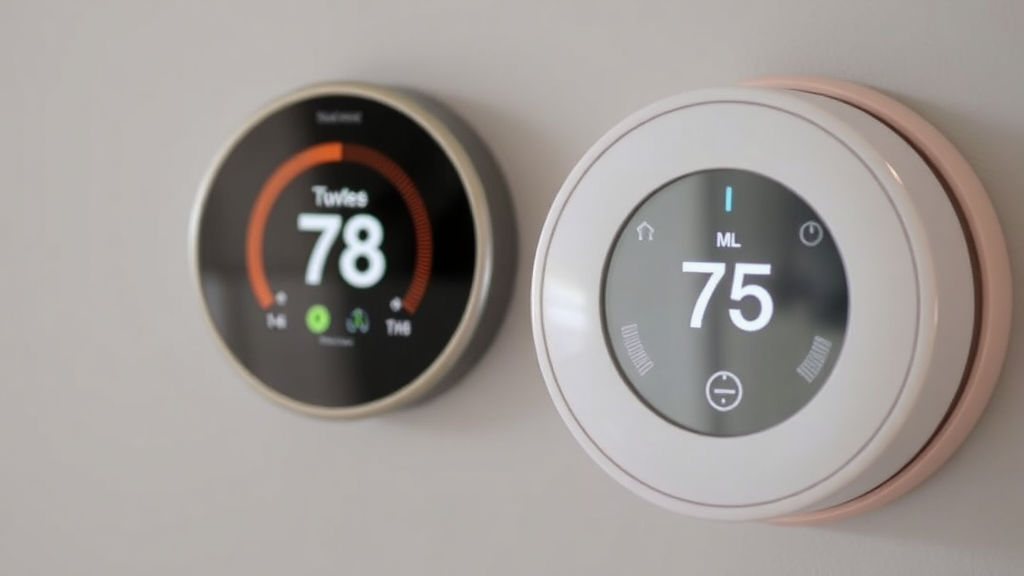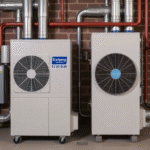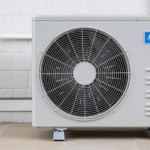Understanding Smart Thermostats: Definition and Functionality
Smart thermostats are becoming increasingly popular for homeowners seeking to enhance energy efficiency and comfort in their living spaces. But what exactly is a smart thermostat, and how does it work? Let’s break this down for better understanding.
A smart thermostat is a device that automatically controls your heating and cooling system. It connects to Wi-Fi, allowing you to manage your home’s climate remotely through your smartphone or tablet. Unlike traditional thermostats, which only allow basic temperature adjustments, smart thermostats offer a range of advanced features that can be customized according to your lifestyle.
Here are some key characteristics of smart thermostats:
- Remote Access: You can set and control your thermostat from anywhere using a mobile app. This is particularly useful if you forget to adjust the temperature before leaving home.
- Learning Algorithms: Many smart thermostats come with learning capabilities. They study your habits over time and can automatically adjust the settings to suit your preferences. For example, if you lower the temperature every night at 10 PM, the thermostat learns this pattern and will do it for you.
- Energy Reports: Smart thermostats often provide insights into your energy usage, helping you understand how to reduce your bills. Some might even offer tips on how to save energy based on your habits.
- Integration with Smart Homes: They can connect to other smart home devices, adding convenience and efficiency to your home. For example, they can integrate with smart lighting systems to optimize energy consumption.
- Motion Sensors: Some models include built-in motion sensors that detect when you are home or away. This allows the thermostat to adjust settings accordingly, saving you energy when you’re not around.
Now, let’s explore how smart thermostats work. Smart thermostats use various technologies to control your home’s heating and cooling systems effectively.
1. Wi-Fi Connectivity: Once installed, a smart thermostat connects to your home Wi-Fi network. This connection enables you to control the device through an app on your smartphone or tablet, allowing adjustments from anywhere.
2. Mobile Applications: Most smart thermostats come with user-friendly apps. These apps facilitate remote control and provide easy access to settings, current temperature, and more. Whether you’re at work or on vacation, you can easily adjust your home’s climate.
3. Learning Features: As mentioned earlier, many smart thermostats utilize machine learning to enhance efficiency. They recognize temperature preferences and create schedules automatically. This means the more you use the thermostat, the better it gets at predicting your needs.
4. Geofencing Technology: Some smart thermostats use geofencing. This technology tracks your phone’s location to determine whether you are home or away. When you leave, the thermostat can switch to an energy-saving mode automatically.
5. Smart Sensors: In addition to motion sensors, smart thermostats may include temperature sensors located in different rooms. This feature helps ensure that the entire home is comfortable rather than just the area where the thermostat is installed.
By implementing all these features, smart thermostats help optimize energy consumption, leading to lower utility bills and a smaller carbon footprint.
If you are considering upgrading to a smart thermostat, be sure to research models that best fit your needs. Manufacturers such as Ecobee and Nest offer popular choices with various functionalities. Additionally, check compatibility with your existing HVAC system before making a purchase.
Furthermore, several resources provide comprehensive guides on installation and choosing the right smart thermostat. Websites such as Energy.gov and Consumer Reports can be particularly useful.
Smart thermostats represent a sophisticated evolution in home climate control. With their blend of technology and user-friendliness, they usher in a new era of comfort and energy savings, making them an invaluable asset in any modern home.
Key Features of Smart Thermostats That Enhance Energy Efficiency
Smart thermostats are becoming increasingly popular due to their ability to significantly enhance energy efficiency in homes and offices. These advanced devices leverage technology to maintain comfortable temperatures while minimizing energy consumption. Let’s explore the key features that make smart thermostats a wise investment for energy-conscious consumers.
Learning Capabilities
One of the standout features of smart thermostats is their learning capability. Many models, like the Nest Learning Thermostat, can learn your heating and cooling preferences over time. By adjusting the temperature based on your habits and schedules, these devices optimize energy use without sacrificing comfort.
Geofencing Technology
Geofencing is another groundbreaking feature found in smart thermostats. This technology allows the thermostat to use your smartphone’s location to determine whether you’re home or away. When you leave a designated area, the thermostat can automatically adjust the temperature, thus saving energy while you’re not there. Returning home? The device can pre-heat or cool your space to a lovely temperature before you even walk through the door.
Remote Control and Monitoring
With smart thermostats, you gain the ability to control and monitor your heating and cooling systems from anywhere using a smartphone app. Whether you’re at work, on vacation, or simply running errands, you can easily adjust the temperature settings to align with your current needs. This flexibility ensures that you won’t waste energy heating or cooling an empty home. Leading manufacturers, such as the Ecobee thermostat, offer apps that show real-time energy usage, allowing you to track your savings over time.
Integration with Smart Home Systems
Smart thermostats are designed to fit seamlessly into your smart home ecosystem. They can integrate with devices like smart speakers, lights, and security systems, creating a unified system that enhances both convenience and energy efficiency. For example, a smart thermostat can work with a smart speaker like Amazon Echo to let you change the temperature using voice commands.
Energy Usage Reports
Another feature that enhances efficiency is the energy usage report. Smart thermostats generate detailed reports showing your energy consumption patterns. By reviewing this data, you can identify areas where you can save energy. For instance, you might notice that you consistently increase your usage during specific months and can adjust your settings for maximum savings. Some smart thermostats, including the Honeywell Lyric, provide monthly summaries to help you analyze your energy habits easily.
Smart Alerts
Smart thermostats can alert you about unusual temperature changes or potential issues with your HVAC system. If there’s a significant drop in temperature, you might receive a notification indicating that your heating system may need attention. This proactive approach can enhance your home’s energy efficiency by ensuring that your systems are working correctly at all times.
Seasonal and Weather Adjustments
Most smart thermostats not only adapt to your habits but also to the changing seasons and varying weather conditions. They can pull weather data from the internet and make adjustments accordingly, ensuring that your home remains comfortable without excessive energy use. By taking advantage of daylight hours and warmer days, these devices can enhance energy efficiency throughout the year.
Multi-Room Control
Some smart thermostats have the capability to control multiple zones or rooms independently. This feature allows you to heat or cool only the areas that are in use, maximizing efficiency across your entire home. Popular models, such as Tado Smart AC Control, enable you to manage the temperature in different rooms using a single interface.
Smart thermostats are not just advanced temperature regulation devices; they offer a plethora of features that enhance energy efficiency and provide convenience. By making use of learning capabilities, geofencing, and integration with smart home systems, you can save money on energy bills while enjoying a comfortable living environment. With features such as energy usage reports and smart alerts, these devices are not only smart but also efficient, working diligently to minimize waste and keep your home at a perfect temperature.
How Smart Thermostats Learn Your Heating and Cooling Preferences
Smart thermostats are impressive gadgets that can greatly improve your home’s energy efficiency and comfort levels. These devices are designed to learn your heating and cooling preferences over time, adapting to your lifestyle and providing a more personalized climate control experience. Understanding how smart thermostats achieve this can help you get the most out of your investment.
One of the primary features of smart thermostats is their ability to gather data about your heating and cooling habits. They achieve this through built-in sensors and Wi-Fi connectivity, allowing them to collect information about your daily routines. Here’s how this process typically works:
- Data Collection: Over time, a smart thermostat collects data about when you are home or away, as well as your temperature preferences. It tracks this information using motion sensors or the app on your smartphone.
- User Input: You can also manually set your desired temperatures for different times of the day. This input helps the thermostat understand your personal preferences more accurately.
- Learning Algorithms: Using advanced algorithms, the smart thermostat processes the collected data to learn patterns and trends. For example, if you usually lower the temperature at 10 PM, the thermostat will start doing that automatically.
- Predictive Adjustments: Smart thermostats can make intelligent predictions based on historical data. If it knows that you often leave for work at a certain time, it can preemptively adjust the temperature to save energy while you are away.
Another essential aspect of smart thermostats is their ability to connect to your home’s Wi-Fi network. This feature enables remote access via a smartphone app, allowing you to adjust the temperature from anywhere. Whether you’re at work or on vacation, you can ensure your home is always at the ideal temperature when you return. Some popular smart thermostat options include devices from brands like Nest, Ecobee, and Hive.
The more your smart thermostat learns about your preferences, the better it performs. This optimization leads to further improvements in energy efficiency and comfort. Here are some benefits of having a smart thermostat that learns your habits:
| Benefit | Description |
|---|---|
| Energy Savings | By adjusting temperatures based on your habits, smart thermostats can reduce unnecessary heating and cooling, leading to lower energy bills. |
| Increased Comfort | A smart thermostat ensures your home stays at your preferred temperature, making it more comfortable to live in. |
| Remote Control | You can easily adjust your home’s climate from anywhere using a smartphone app, adding convenience to your life. |
| Smart Integration | Many smart thermostats can integrate with other smart home devices for enhanced functionality, like security cameras or smart lighting. |
Moreover, smart thermostats often come with features such as geofencing. This technology allows the thermostat to adjust the temperature based on your location. For example, if you leave your home, the smart thermostat detects that you are no longer there and adjusts the temperature to save energy. When you’re on your way back, it will ensure your home is at your desired comfort level by the time you arrive.
As such, investing in a smart thermostat that learns your heating and cooling preferences can dramatically change how you manage your home climate. Since these devices evolve with your habits, they provide an excellent long-term solution for energy savings and comfort. Many brands also offer energy usage reports through their apps, allowing you to monitor your efficiency over time and make desired changes.
For further reading on smart thermostats, you can explore resources like Energy.gov or check out reviews at Tom’s Guide to find the right smart thermostat for your needs. Learning how these technologies work gives you the power to improve not only your home’s comfort but also your energy efficiency for a greener lifestyle.
The Role of Smart Thermostats in Smart Home Ecosystems
Smart thermostats play a crucial role in the evolving landscape of smart home ecosystems. By integrating advanced technology with everyday heating and cooling functionalities, they not only enhance comfort but also promote energy efficiency. Understanding the benefits and functionalities of smart thermostats can help you make an informed decision about incorporating them into your home.
What is a Smart Thermostat?
A smart thermostat is a device that enables you to control your home’s heating and cooling system remotely via the internet. These thermostats connect to your home’s Wi-Fi network and can be managed through a smartphone app or web interface. They are designed to learn your habits and preferences, adjusting the temperature automatically for optimal comfort and energy savings.
Key Features of Smart Thermostats
- Remote Access: You can control your thermostat from anywhere using a smartphone or tablet.
- Learning Capabilities: Many smart thermostats learn your schedule and temperature preferences, adjusting automatically.
- Energy Reports: They provide insights into your energy consumption and help you identify ways to save on your bill.
- Integration with Other Smart Devices: Smart thermostats can communicate with other devices, like smart speakers and security systems.
- Geofencing: They can use your phone’s location to adjust the temperature when you leave or arrive home.
Benefits of Using Smart Thermostats
Integrating a smart thermostat into your home offers numerous advantages that contribute to a more efficient and comfortable living environment:
- Energy Efficiency: By optimizing heating and cooling cycles, smart thermostats can significantly reduce your energy consumption. According to the U.S. Department of Energy, homeowners can save up to 10-15% on their heating and cooling costs.
- Convenience: With the ability to control your system remotely, managing your home’s temperature has never been easier. You can make adjustments on-the-go without being physically present.
- Increased Comfort: By learning your routines and preferences, these devices can maintain a comfortable atmosphere that suits your needs throughout the day.
- Scheduling Options: Create customized schedules for different times of day to ensure your home is always at the ideal temperature.
Integration with Smart Home Ecosystems
Smart thermostats serve as a vital link within the smart home ecosystem, connecting with various products that enhance your overall experience:
- Smart Speakers: Many smart thermostats can be controlled by voice commands through devices like Amazon Echo or Google Home.
- Smart Lights and Shades: Integration with smart lighting allows the thermostat to adjust based on the natural light entering your home.
- Home Security Systems: When paired with a security system, the thermostat can adjust settings when your security system is activated or deactivated.
Choosing the Right Smart Thermostat
When selecting a smart thermostat, consider the following factors:
| Feature | Considerations |
|---|---|
| Compatibility | Ensure it works seamlessly with your existing HVAC system. |
| User Interface | Look for a model with an intuitive app and display. |
| Budget | Evaluate the cost versus features and potential savings. |
To explore a range of options, you can check resources like CNET or Consumer Reports. These sites offer comprehensive reviews and comparisons to help you make an informed decision.
Smart thermostats not only provide enhanced control over your home’s climate but also contribute to a more energy-efficient and comfortable environment. With features that adapt to your lifestyle, integrating a smart thermostat within your smart home ecosystem is a step towards modernizing your home and embracing a more convenient lifestyle.
Comparing Smart Thermostats: Popular Brands and Models
When it comes to smart thermostats, many homeowners are eager to find the best model to efficiently manage their heating and cooling systems. Smart thermostats not only provide user-friendly controls but also offer energy-saving features that can lead to significant savings. Let’s explore some popular brands and models to help you make an informed decision.
Ecobee SmartThermostat
Ecobee has made a name for itself with its innovative smart thermostats. The Ecobee SmartThermostat with Voice Control is one of their flagship models. It offers a range of features including:
- Voice control through built-in Amazon Alexa
- Room sensors for detecting occupancy and temperature
- Remote access via a smartphone app
- Integration with various smart home devices
- Energy reports for tracking savings
This model is particularly beneficial for homes with multiple rooms, providing precise temperature control and ensuring comfort wherever you are.
Nest Learning Thermostat
The Nest Learning Thermostat by Google is another popular choice among smart thermostat users. Known for its sleek design and user-friendly interface, it boasts an impressive array of features:
- Self-learning capabilities that adapt to your schedule
- Remote control through a mobile app
- Energy History insights to monitor usage
- Integration with Google Home and other smart devices
- Farsight feature that lights up when you enter the room
The Nest Learning Thermostat is excellent for those who appreciate a product that learns from your habits and optimizes your heating and cooling accordingly.
Honeywell Home T9 Smart Thermostat
The Honeywell Home T9 Smart Thermostat is gaining traction for its practicality and efficiency. It combines comfort with features that suit a busy lifestyle:
- Smart room sensors to manage specific areas of your home
- Voice control compatibility with Amazon Alexa and Google Assistant
- Flexible scheduling systems
- Alerts for maintenance and filter changes
With these features, Honeywell provides a strong contender for those looking to optimize their home’s climate efficiently.
Compare Smart Thermostat Features
| Feature | Ecobee SmartThermostat | Nest Learning Thermostat | Honeywell Home T9 |
|---|---|---|---|
| Voice Control | Yes | Yes | Yes |
| Room Sensors | Yes | No | Yes |
| Learning Capability | No | Yes | No |
| Mobile App Access | Yes | Yes | Yes |
| Energy Reports | Yes | Yes | No |
Other Notable Brands
While Ecobee, Nest, and Honeywell dominate the market, several other brands provide smart thermostats worth considering:
- Emerson Sensi Touch: This thermostat is budget-friendly and provides straightforward features for simple home automation.
- Friedrich Kühl: Known for its ability to control window air conditioning units remotely.
Selecting the right smart thermostat involves evaluating your priorities, from budget to specific features that fit your home’s needs. With features tailored for convenience, energy efficiency, and user preferences, smart thermostats provide a modern solution for heating and cooling.
As technology evolves, more brands and models are likely to emerge. Explore your options and consider the integration of your smart thermostat with existing devices for a seamless home automation experience.
Installation and Setup: Transitioning to a Smart Thermostat
Transitioning to a smart thermostat can significantly enhance your home’s energy efficiency and comfort. To begin, it’s essential to understand what a smart thermostat is and how it fits into your existing heating and cooling system.
Smart thermostats are advanced devices that allow users to control their home’s temperature remotely via a smartphone app or web interface. Unlike traditional thermostats, smart versions learn your preferences over time, allowing for more automated and efficient temperature adjustments.
Gather Your Materials
Before you dive into the installation process, make sure you have everything you need. Here’s a checklist to help:
- Smart thermostat model
- Screwdriver
- Drill (if needed)
- Level
- Wire stripper
- Smartphone for app setup
Turn Off Your Power
Safety should always be your first priority. To avoid any electrical mishaps, turn off the power to your HVAC system at the circuit breaker. This step will prevent any unwanted electrical shocks during installation.
Remove the Old Thermostat
Using a screwdriver, carefully remove the cover of your old thermostat. Take a picture of the wiring for reference, as it will assist you when connecting the smart thermostat. Unscrew the thermostat base and gently disconnect the wires. Make sure to label each wire with its corresponding letter to avoid confusion during the installation process. Here’s a common wiring guide:
| Wire Color | Function |
|---|---|
| Red | Power (R) |
| White | Heat (W) |
| Green | Fan (G) |
| Yellow | Cooling (Y) |
| Blue or Black | Common (C) |
Connect the Smart Thermostat
Now it’s time to install your new smart thermostat. Start by attaching the base to the wall. Use a level to ensure it is straight before securing it with screws. Next, connect the wires to the corresponding terminals on the smart thermostat. Make sure to tighten them securely to prevent any connection issues.
Attach the Thermostat Display
After connecting the wires, gently attach the display portion of the smart thermostat to the base. Most smart thermostats will click into place easily. Be careful not to pull on the wires while doing this.
Power On and Configure
Now that the hardware installation is complete, turn the power back on at your circuit breaker. Your smart thermostat should light up and guide you through the initial setup process. During this setup, you’ll typically need to connect it to your Wi-Fi network and download the manufacturer’s app on your smartphone. Make sure to follow the on-screen prompts closely.
Customize Your Settings
Once connected, open the app on your smartphone. Many smart thermostats offer features such as geofencing, scheduling, and energy reports. Take the time to customize your settings according to your lifestyle. For example, you can set the temperature to adjust automatically when you leave home and return.
Monitor Performance
After installation, it’s a good idea to monitor your smart thermostat’s performance. Pay attention to your energy bills over the next few months to track any changes in usage. You may notice savings and a more comfortable living space as the thermostat learns your habits.
In case you encounter any issues, check the manufacturer’s website or their support page for troubleshooting tips. Popular smart thermostat brands include Nest, Ecobee, and Honeywell Home.
With the right setup, a smart thermostat not only automates your home’s heating and cooling but also contributes to energy savings and increased comfort. By following these steps, you can enjoy the benefits of modern HVAC technology in no time!
Future Trends in Smart Thermostat Technology and Home Automation
The landscape of home automation continues to evolve as technology advances, particularly in the realm of smart thermostats. These innovative devices are becoming an integral part of modern homes, combining comfort, energy efficiency, and intelligent control. As we look forward, several exciting trends in smart thermostat technology are shaping the future of home automation.
Enhanced Energy Management
Smart thermostats are transitioning from basic programmable models to advanced systems with sophisticated energy management features. These devices now include:
- Machine Learning: Smart thermostats learn your heating and cooling preferences over time, optimizing schedules to save energy without sacrificing comfort.
- Adaptive Algorithms: They can adapt to real-time energy prices, enabling users to adjust their usage when rates are lower, thereby maximizing savings.
- Home Energy Reports: Many devices now provide detailed insights into energy consumption, helping homeowners understand usage patterns and make informed decisions.
Integration with Smart Home Ecosystems
Smart thermostats are increasingly becoming part of a broader smart home ecosystem. They can seamlessly connect with other devices, enhancing user experience and functionality. Some key integrations include:
- Smart Speakers: Voice-activated control through devices such as Amazon Alexa and Google Assistant allows users to adjust temperatures hands-free.
- Home Automation Hubs: Devices can communicate with other home security systems, lights, and appliances, allowing for coordinated smart home scenarios like “leaving home” or “night mode.”
- Environmental Sensors: Integration with sensors monitoring humidity, air quality, and occupancy can lead to even smarter temperature adjustments.
Geofencing Capabilities
Geofencing technology is becoming common in many smart thermostats. This feature uses the location of your smartphone to determine if you are home or away. Benefits include:
- Automatic Adjustments: The thermostat can adjust temperatures automatically as you leave or approach home, ensuring comfort without unnecessary energy use.
- Remote Access: You can control settings remotely using an app, ensuring that you return to a cozy home even when you’re away.
Increased User Experience
User-friendly interfaces are rapidly becoming a hallmark of smart thermostat technology. With the advancement of mobile apps and touchless interfaces, homeowners enjoy features like:
- Intuitive Controls: Modern interfaces offer easy navigation, allowing users to customize settings smoothly.
- Visual Insights: Clear graphs and reports provide visual feedback on energy consumption and savings.
Future of AI in Temperature Control
Artificial intelligence (AI) is expected to play a crucial role in the evolution of smart thermostats. Future developments may include:
- Predictive Algorithms: AI can predict future temperature needs based on historical data and weather forecasts, optimizing comfort and efficiency.
- Proactive Maintenance Alerts: Smart thermostats with AI can detect system inefficiencies and alert users before issues escalate, saving on repair costs.
Environmental Sustainability
As awareness about climate change grows, smart thermostat technology is expected to align with sustainability goals. Innovations may feature:
- Energy Usage Monitoring: Helping homeowners adhere to renewable energy use schedules, these devices can ensure green energy is utilized when available.
- Partnerships with Utility Companies: Smart thermostats may be integrated with energy grids, participating in demand response programs that help balance overall energy consumption.
To explore more on smart thermostat technology, visit Energy.gov for in-depth information and resources. Additionally, consider checking out CNET’s guide on smart thermostats for reviews and comparisons.
As these trends unfold, understanding and adopting smart thermostat technologies will provide significant advantages, from enhanced comfort to savings on energy bills. Embracing these innovations enables a sustainable future for homeowners while adapting to lifestyles and preferences.
Key Takeaway:
Key Takeaway:
Smart thermostats are innovative devices that offer a wealth of features geared toward enhancing energy efficiency while providing convenience in managing your home’s heating and cooling systems. By understanding what a smart thermostat is and how it works, you can harness the full potential of this technology to optimize your home environment.
At its core, a smart thermostat is a programmable device that learns your temperature preferences and adjusts accordingly, which not only keeps you comfortable but also reduces wasted energy and lowers your utility bills. Key features, such as remote control via smartphone apps, energy usage reports, and geofencing, empower you to manage your HVAC system effectively. This functionality can lead to significant savings on energy costs.
The learning capability of smart thermostats is a standout feature. These devices analyze your schedule and preferences over time, adapting to your patterns to create an optimal heating and cooling schedule. This self-learning process means that the thermostat becomes more intuitive and efficient the longer you use it.
Moreover, smart thermostats are essential components of smart home ecosystems. They can integrate with other smart devices such as lights, security systems, and voice assistants, allowing for a seamless home automation experience. This integration means you can coordinate home energy use with other smart features to enhance comfort and security.
As you consider switching to a smart thermostat, it’s crucial to compare various popular brands and models to find one that suits your specific needs. Each brand may offer different features, installation processes, and levels of user-friendliness.
Installing a smart thermostat may seem daunting but can often be done without professional help. Many models come with detailed instructions that simplify the setup process, making it accessible even for the less technically inclined.
Looking toward the future, trends in smart thermostat technology suggest that advancements will continue to focus on improving user experience, integrating AI capabilities, and expanding energy-saving features. As you make the transition to a smart thermostat, you’ll not only enjoy enhanced comfort but also contribute to a more energy-efficient home and a greener planet. embracing smart thermostat technology can lead to significant benefits in comfort, energy savings, and home automation, positioning your home at the forefront of modern living.
Conclusion
As you explore the world of smart thermostats, it’s clear that these devices are more than just temperature regulators; they are essential components of modern, energy-efficient homes. With their advanced functionality, smart thermostats learn your heating and cooling preferences over time, allowing for tailored comfort and reduced energy consumption. The key features, such as remote access and integration with smart home ecosystems, make them a compelling choice for anyone looking to optimize their living environment.
These devices can help not only in cutting costs on energy bills but also in enhancing your quality of life with programmable settings and energy usage insights. When comparing popular brands and models, you’ll find that each offers unique advantages, ensuring that there’s a perfect fit for your home’s needs. Transitioning to a smart thermostat is straightforward and can typically be done quickly with some basic DIY skills, resulting in long-term savings and convenience.
Looking ahead, the future of smart thermostat technology promises even more innovation, including improved AI learning algorithms, adaptive energy management, and deeper integration with other smart devices in your home. As you consider upgrading your home’s heating and cooling system, investing in a smart thermostat could be one of the best decisions for comfort, efficiency, and a sustainable future. The shift towards smarter homes is only just beginning, and making the leap now will ensure you’re ahead of the curve in managing your home’s climate effectively.







Leave a Reply